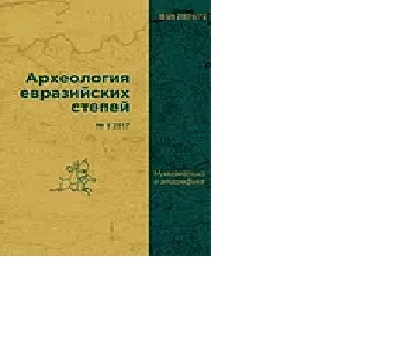COINS ON THE GREAT SILK ROUTE (KYRGYZSTAN)
Keywords:
The Great Silk Route, caravan trade,, monetary circulation, Kyrgyzstan territory,, coins of China, Tang dynasty, Karakhanid dynasty.Abstract
The primary task in the study of trade relations on the Great Silk Route is the recording of accidental findings
and foreign coin hoards. The article features an overview of such numismatic findings discovered in the territory of
Kyrgyzstan. It also presents the periodization of the development of monetary circulation along the Great Silk
Route covering the period between the 1st century B.C. and the 13th century A.D. Four periods are considered in the
article, each of them characterized by a unique selection of foreign and domestic coins. As noted by the authors, the
first period is characterized by the the possible use of Roman and Parthian coins as an international currency on the
Great Silk Route (however, this hypothesis requires additional confirmation), as well as the spread of Chinese coins
across the eastern regions of Central Asia where it was also presumably used as a currency. In the second period
(4th – mid-7th centuries) the international currency used throughout the entire Great Silk Route were Sasanian and
Byzantine coins. Sasanian coins have been discovered in the territory along the entire central and eastern portions
of the Great Silk Route. At the same time, golden Byzantine coins were supplied in the eastern direction along its
northern branch. In the third period, the role of money was played by bronze Tang coins which circulated throughout
the eastern and central portions of the Great Silk Route from China to Sogd. With the establishment of Arab
Caliphate, the stream of Sasanian and Byzantine coins made of noble metals was replaced by a flow of dirhams and
dinars from Muslim states. The fourth period is characterized by the circulation of Karakhanid silver dirhams, and
with the aggravation of the ‘silver crisis’ – by the circulation of gold dinars (both whole and shattered) of various
Oriental dynasties, primarily Khwarazmshahs, Gurids and Karakhanids. Until the Mongol conquest in the 13th century,
the role of an international currency was played by gold. The establishment of the Mongol Empire ‘brought to
life’ the abandoned silver mines, and silver coinage returned, filling the local markets with coins.
References
Бабаяров Г.Б. Древнетюркские монеты Чачского оазиса (VI–VIII вв. н.э.). Ташкент: изд. Национальной библиотеки Узбекистана им. Алишера Навои, 2007. 120 с.
Бартольд В.В. Двенадцать лекций по истории турецких народов Средней Азии // Собрание Сочинений. Т. V. М.: «Наука», 1968. С. 19–192
Бернштам А.Н. Историко-культурное прошлое Северной Киргизии по материалам Большего Чуйского канала // Избранные труды по археологии и истории кыргызов и Кыргызстана. В 2-х томах. Т. 1.Бишкек, 1997. С. 140–173.
Бичурин Н.Я. (Иакинф). Собрание сведений о народах, обитавших в Средней Азии в древние времена / Ред., вступ. статья, коммен. А.Н. Бернштам и Н.В. Кюнера. Т. II. М.-Л.: АН СССР, Институт этнографии им. Миклухо-Маклая, 1950. 334 с.
Горбунова Н.Г. Ивочкина Н.В. Монеты у-шу из могильников Ферганы // Сообщения ГЭ. Л.: «Искусство», 1988. С. 45–50.
Давидович Е.А. Денежное обращение в Мавераннахре при Саманидах // НЭ. Т. VI. М.: «Наука»,1966. С. 103–134.
Ивочкина Н.В. Монеты первой Восточно-Туркестанской экспедиции С.Ф. Ольденбурга // Культура и искусство Индии и стран Дальнего Востока. Л.: «Аврора», 1975. С. 27–38.
Зеймаль Е.В. Древние монеты Таджикистана. Душанбе: «Дониш», 1983. 342 с.
Зеймаль Е.В. Денежное обращение в Восточном Туркестане // Восточный Туркестан в древности и раннем: Хозяйство, материальная культура / Под ред. акад. Б.А. Литвинского. М.: «Восточная литература», 1995. С. 430–472.
Камышев А.М. Монеты Китая из Кыргызстана // Нумизматика Центральной Азии. Вып. IV. Ташкент, 1999. С. 57–65.
Камышев А.М. Монеты на Великом шелковом пути их влияние на возникновение денежных отношений в Семиречье // Материалы международной научной конференции. (Бишкек 26–27 сентября 2001 г.). Бишкек, 2002. С. 58–65.
Камышев А.М. Раннесредневековый монетный комплекс Семиречья. Бишкек, 2002. 145 с.
Массон М.Е. Монетные находки зарегистрированные в Средней Азии в 1930 и 1931 гг. // Мате-
риалы Узкомстариса. Вып. 5. Ташкент, 1933. 18 с.
Массон М.Е. К вопросу о взаимоотношениях Византии и Средней Азии по данным нумизматики
// Труды Среднеазиатского государственного университета. Вып. XXIII. Ташкент, 1951. С. 91–104
Петров П.Н., Камышев А.М. Находки джучидских монет в Кыргызстане // НЗО. 2013. № 3. С. 61-67.
Ртвеладзе Э.В. Великий шелковый путь. Энциклопедия. Ташкент: «Узбекистон миллий энциклопедияси», 1999. 280 с.
Федоров М.Н. Находки медной римской монеты // Археологические памятники Прииссыккулья.Фрунзе: «Илим», 1975. С. 83–86.
Федоров М.Н. Нумизматические источники // Источниковедение Кыргызстана (с древности до XIX в.). Бишкек: «Илим», 1996. С. 274–283.

Downloads
Published
How to Cite
Issue
Section
License
Copyright (c) 2017 A.M. Kamyshev

This work is licensed under a Creative Commons Attribution-NonCommercial 4.0 International License.







